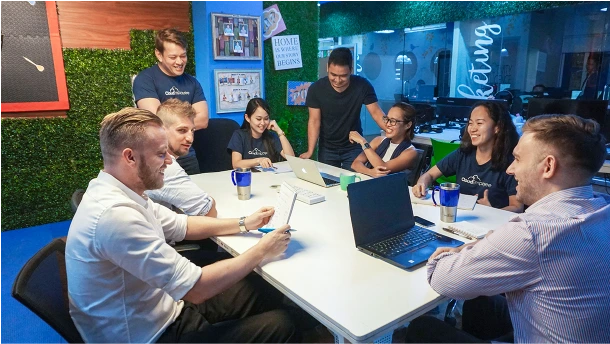What is the usual rate for Android developers?
If you are new to outsourcing your mobile app development, it can be hard to estimate how much it costs to hire an Android developer and build a mobile app. For starters, take a look at this table comparing the average annual salary and hourly rates of Android developers from four different countries. The data presented below is taken from PayScale.
| |
Average Android Developer Annual Salary |
Average Android Developer Hourly Rate |
| United Kingdom |
GBP 35,365 |
GBP 28.50 |
| United States |
USD 97,777 |
USD 30 |
| Canada |
CAD 65,847 |
CAD 21 |
| Australia |
AUD 81,098 |
AUD 32.50 |
Companies from startups to large firms who are looking to reduce costs on operations and recruitment are turning to other options, such as working with IT outsourcing providers, to further reduce their costs on operations and recruitment.
Here at Cloud Employee, we know and understand this need for firms and organisations to find Android developers for hire who can help expand their operations and scale their businesses. You can find the best Android developers offshore with us at competitive industry rates fast and risk-free.
For a helpful guide on IT outsourcing costs, here’s a quick yet informative read about offshore developer rates from different outsourcing regions.
What interview techniques should you use to hire the best Android developer?
During interviews, it is important for you as the interviewer to ask the right questions to be able to find the right hire. After you have asked the usual generic questions to get a feel of their personality and work ethics, it is now time to ask technical questions to find out how much your candidate knows about Android development. Here are some questions you can ask:
Q: What notifications are available in Android and what are their uses?
A: Snackbars & Toast Notifications. Snackbars and Toast notifications show up as a pop-up message on the surface of the window.
Snackbars are temporary, closable notifications typically containing a single line of text related to the operation performed without icons. Only one snackbar can be displayed at a time.
Toasts, on the other hand, are used for system messages. They are displayed at the bottom of the screen but can’t be swiped off-screen.
Q: What types of flags are used to run an application in Android?
A:
FLAG_ACTIVITY_NEW_TASK
FLAG_ACTIVITY_CLEAR_TOP
Q: Please name the 7 life-cycle methods of Android activity and give a short explanation about each one.
A: Here are the 7 life-cycle methods of Android activity:
onCreate()
Called when an activity is created. This is where all normal static setups should be done: create views, bind data to lists, etc. This also provides a Bundle containing the activity’s previously frozen state, if there was one. This is always followed by onStart().
onRestart()
Called after the activity has stopped prior to being started. This is always followed by onStart().
onStart()
Called when the activity is becoming visible to the user. If the activity comes to the foreground this is followed by onResume(); if the activity becomes hidden this is followed by onStop().
onResume()
Called when the activity has started interacting with the user. At this point, your activity is at the top of the activity stack with user input going to it. This is always followed by onPause().
onPause()
Called when the activity is not visible to the user but has not (yet) been killed. This is the counterpart to onResume(). This callback will be invoked on activity A when activity B is launched in front of it. B will not be created until A’s onPause() returns.
onStop()
Called when the activity is no longer visible to the user. Depending on the user activity, this is either followed by onRestart(), onDestroy(), or nothing.
In low memory situations, this method may never be called because there is not enough memory to keep the activity’s process running after the onPause() method is called. This method may never be called in low memory situations because the system does not have enough memory to keep your activity’s process running after the onPause() method is called.
onDestroy()
The final call before the activity is destroyed. This happens either because someone called a finish() on the activity, or because the system has to destroy the activity temporarily to save space.
Q: What is a thread, and how do you create a new thread of execution?
A: A thread is a sequence of executions in a program. Threads with higher priority are executed in preference to threads with lower priority.
There are two ways to create a new thread of execution. The first way is by declaring a class to be a subclass of a thread; the subclass overrides the run method of class Thread. Here is an example of a thread that computes primes larger than a given value:
class PrimeThread extends Thread {
long minPrime;
PrimeThread(long minPrime) {
this.minPrime = minPrime;
}
public void run() {
// compute primes larger than minPrime
. . .
}
}
This code will then create a thread and run it:
PrimeThread p = new PrimeThread(143);
p.start();
The second way to create a thread is by declaring a class that implements a Runnable interface. Here is an example:
class PrimeRun implements Runnable {
long minPrime;
PrimeRun(long minPrime) {
this.minPrime = minPrime;
}
public void run() {
// compute primes larger than minPrime
. . .
}
}
This code will then create a thread and run it:
PrimeRun p = new PrimeRun(143);
new Thread(p).start();
How can Cloud Employee help you?
Here at Cloud Employee, we help startups and tech firms bring their ideas into realisation. We’re a fast-growing UK-managed IT outsourcing company in the Philippines connecting businesses in the UK, the US, and Australia to expert developers in the country. Find thousands of available Android developers for hire with a reliable outsourcing partner in Cloud Employee.
You can start finding your Android developer today by sending us your staffing requirements, skills, years of experience required, and other important details. We conduct a custom search for skilled and available Android developers matching your needs, and afterwards, we send you a shortlist of candidate CVs. From this list, you personally handpick the developers you want to interview and invite for technical testing. You hire only the Android developer you want at no recruitment fees.
As your reliable outsourcing partner, we take care of your Android developers for you. We provide them with the necessary hardware, software, and high-speed internet connection here at our modern offices. We also take care of everything else: payroll, taxes, HR and general admin.
If your business relies on mobile technology, outsourcing your Android development can be a practical option. Find Android developer for hire with Cloud Employee today! Our Android developers are also skilled in Android Studio, Android SDK, Java, Corona SDK, SQLite, MySQL, JavaScript, HTML5, CSS3.
What is the dedicated developer model?
Cloud Employee employs the Dedicated Hiring Model which is tailored ultimately for your benefit and convenience. In this model, we provide you with dedicated offshore Android developers, equipment, and resources based on your project’s requirements. You pay a single sum of money which constitutes the team member’s monthly salary and the outsourcing provider’s fee. You only pay for what you need.
The biggest benefit of our dedicated hiring model is that it helps you integrate your outsourced teams into your in-house teams seamlessly. They become part of your infrastructure and project methodologies, reducing risks of miscommunication and unmet deadlines.
Pros
- Good choice for long-term projects with unclear requirements and frequently changing project scope
- Has a predictable budget even without a definite project scope
- You gain full control over the recruitment, selection, and management of your outsourced dedicated team
- The outsourced team exclusively works for you
- With this setup, your outsourced team gains a good understanding of your objectives and expectations
Cons
- Can be a waste of money if there are little to no tasks for the outsourced team
- This can be time-consuming if you have little to no time to directly work with your outsourced team
This model works best if used in any of the following situations:
- If you prefer to have a dedicated team to work on your project
- If you would like to cut down on search and recruitment expenses.
- If you need flexibility in terms of hiring, workload, and scalability during the development.
Aside from working 100% exclusively for you, your outsourced Android developer or Android development team uses only your preferred tools and standards, making them an effective extension of your in-house team.




















